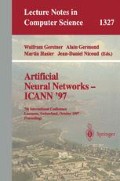Abstract
To some extent or other all classifiers are subject to the curse of dimensionality. Consequently, pattern classification is often preceded with finding a reduced dimensional representation of the patterns. In this paper we empirically compare the performance of unsupervised and supervised dimensionality reduction techniques. The data set we consider is obtained by segmenting cells in cytological preparations and extracting 9 features from each of the cells. We evaluate the performance of 4 dimensionality reduction techniques (2 unsupervised) and (2 supervised) with and without noise. The unsupervised techniques include principal component analysis and self-organizing feature maps, while the supervised techniques include Fisher's linear discriminants and multi-layered feed-forward neural networks. Our results on a real world data set indicate that multi-layered feed-forward neural networks outperform the other three dimensionality reduction techniques and that all techniques are sensitive to noise.
Preview
Unable to display preview. Download preview PDF.
References
R. Bellman, Adaptive Control Processes: A Guided Tour, New Jersey: Princeton University Press, 1961.
J. Mao, and A. K. Jain, “Artificial Neural Networks for Feature Extraction and Multivariate Data Projection” IEEE Transactions on Neural Networks, vol. 297, pp. 296–317, 1995.
I. T. Jolliffe, Principal Component Analysis, New York: Springer-Verlag, 1986.
T. Kohonen T,Self Organizing Maps, Berlin: Springer Verlag, 1995.
H. Ritter, K. Schulten, “On the Stationary State of Kohonen's Self-oOganizing Sensory Mapping,” Biological Cybernetics, vol. 54, pp. 99–106, 1986.
R. A. Fisher, “The Use of Multiple Features in Taxonomic Problems,” Annals of Eugenics, Vol. 7, pp. 179–188, 1936.
R. O. Duda, and P. E. Hart, Pattern Classification and Scene Analysis New York: John Wiley, 1973.
D. E. Rumelhart, G. E. Hinton, and R. J. Williams, “Learning Internal Representations by Back-Propagating Errors,” Nature, vol. 332, pp. 533–536, 1986.
R. M. Haralick, and L. G. Shapiro, Computer and Robot Vision, I, Massachusetts: Addison Wesley, 1992.
M. Kass, A. Whitkin, and D. Terzopoulos, “Snakes-Active Contour Models,” Proc. Intl. Conf. on Comp. Vis., pp. 259–269, 1987.
R. Kothari, T. Balachander, R. Lotlikar, and H. Cualing, “Decision Theoretic Cytodiagnois of Lymphoma,” Submitted.
M. H. Zhweig, and G. Campbell, “Receiver Operating Characterstic (ROC) Plots: A Fundamental Evaluation Tool in Clinical Medicine,” Clinical Chemistry, vol. 39, pp. 561–577, 1993.
Author information
Authors and Affiliations
Editor information
Rights and permissions
Copyright information
© 1997 Springer-Verlag Berlin Heidelberg
About this paper
Cite this paper
Balachander, T., Kothari, R., Cualing, H. (1997). An empirical comparison of dimensionality reduction techniques for pattern classification. In: Gerstner, W., Germond, A., Hasler, M., Nicoud, JD. (eds) Artificial Neural Networks — ICANN'97. ICANN 1997. Lecture Notes in Computer Science, vol 1327. Springer, Berlin, Heidelberg. https://doi.org/10.1007/BFb0020218
Download citation
DOI: https://doi.org/10.1007/BFb0020218
Published:
Publisher Name: Springer, Berlin, Heidelberg
Print ISBN: 978-3-540-63631-1
Online ISBN: 978-3-540-69620-9
eBook Packages: Springer Book Archive

